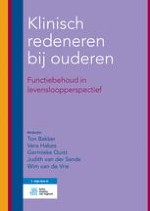2017 | OriginalPaper | Hoofdstuk
8b Delier: ‘wisselend bewolkt’ bewustzijn
Auteur : Herbert Habets
Gepubliceerd in: Klinisch redeneren bij ouderen
Uitgeverij: Bohn Stafleu van Loghum
Samenvatting
-
Een delier (acute psychische stoornis) dient als een ernstig alarmsignaal beschouwd te worden: een onderliggende (acute) lichamelijke ontregeling is veelal de oorzaak. Ondanks deze ernst wordt een delier dikwijls niet tijdig herkend. Er zijn twee uitingsvormen: het hyperactieve en het hypoactieve delier. Bij ouderen wordt vaak een mengvorm gezien: de patiënt is afwisselend hyper- en hypoactief (paragraaf 8b.1).
-
De prevalentie onder de algemene bevolking is laag, maar bij ouderen in het ziekenhuis of verpleeghuis ligt deze hoger, respectievelijk 18-37% en 23-72% (paragraaf 8b.2).
-
De pathofysiologie van het delier hangt wellicht samen met neuro-inflammatie en verstoringen van neurotransmittersystemen. Ook een verstoring van het cholinerge systeem zou mogelijk een cruciale rol spelen bij het ontstaan van een delier (paragraaf 8b.3).
-
Externe en persoonlijke factoren (paragraaf 8b.4):Predisponerende factorenPrecipiterende factorenLeeftijd boven de 65 jaarInfectie, bijvoorbeeld van de luchtwegen, urinewegen of na een chirurgische ingreepPre-existente cognitieve stoornis of dementieAcuut trauma, maar ook electieve operatieve ingreepDelier tijdens eerder doorgemaakte ziekte en/of ziekenhuisopnameSlaaptekortErnst van de ziekte, gedefinieerd als een klinische toestand die aan verslechtering onderhevig is of die op korte termijn kan verslechterenDehydratieVisusstoornisAfwezigheid van klok, kalender, leesbril of vertrouwde familieleden(Heup)fractuur bij opnameKamerwisselingen tijdens het ziekenhuisverblijfUrineretentieToepassing van vrijheidsbeperkende middelen/fixatieGebruik van geneesmiddelen met psychoactieve werkingKathetergebruik
-
Vooralsnog is er geen gevalideerd delierrisico-instrument beschikbaar. Documentatie van risicofactoren in het patiëntendossier wordt aanbevolen. Bij de screening wordt veel gebruikgemaakt van de DOSS, maar deze schaal is minder geschikt bij personen met dementie. Voor de diagnostiek van een delier is de CAM de gouden standaard (paragraaf 8b.5).
-
De behandeling van een delier bestaat uit drie basiscomponenten (paragraaf 8b.6).1.Het opsporen en indien mogelijk behandelen van de oorzaken van het delier.2.Het optimaliseren van de communicatie (met de patiënt) en de oriëntatie.3.Het zorgen voor een passende, veilige omgeving en een goede nachtrust.
-
Een medicamenteuze behandeling van het delier wordt pas gestart als blijkt dat de niet-medicamenteuze interventies onvoldoende werkzaam zijn en er bijvoorbeeld sprake is van ernstige symptomen. Haloperidol geldt als middel van eerste keuze voor de behandeling van de symptomen van een delier (paragraaf 8b.6).
-
Het Hospital Elder Life Program (HELP) is een best-practice-voorbeeld van een kosteneffectief preventief interventieprogramma dat de incidentie van delier significant vermindert (paragraaf 8b.6.1).
-
Bij de overdracht van informatie bij ontslag van de patiënt dient informatie opgenomen te worden over het delierrisico, over preventieve interventies en over het resultaat. Een doorgemaakt delier en de behandeling dienen vermeld te worden (paragraaf 8b.7).
